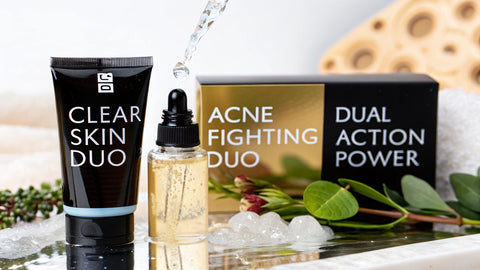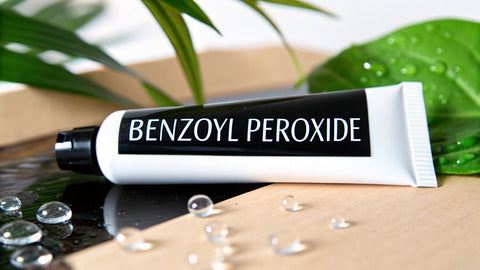When to Use Salicylic Acid for Clearer Skin
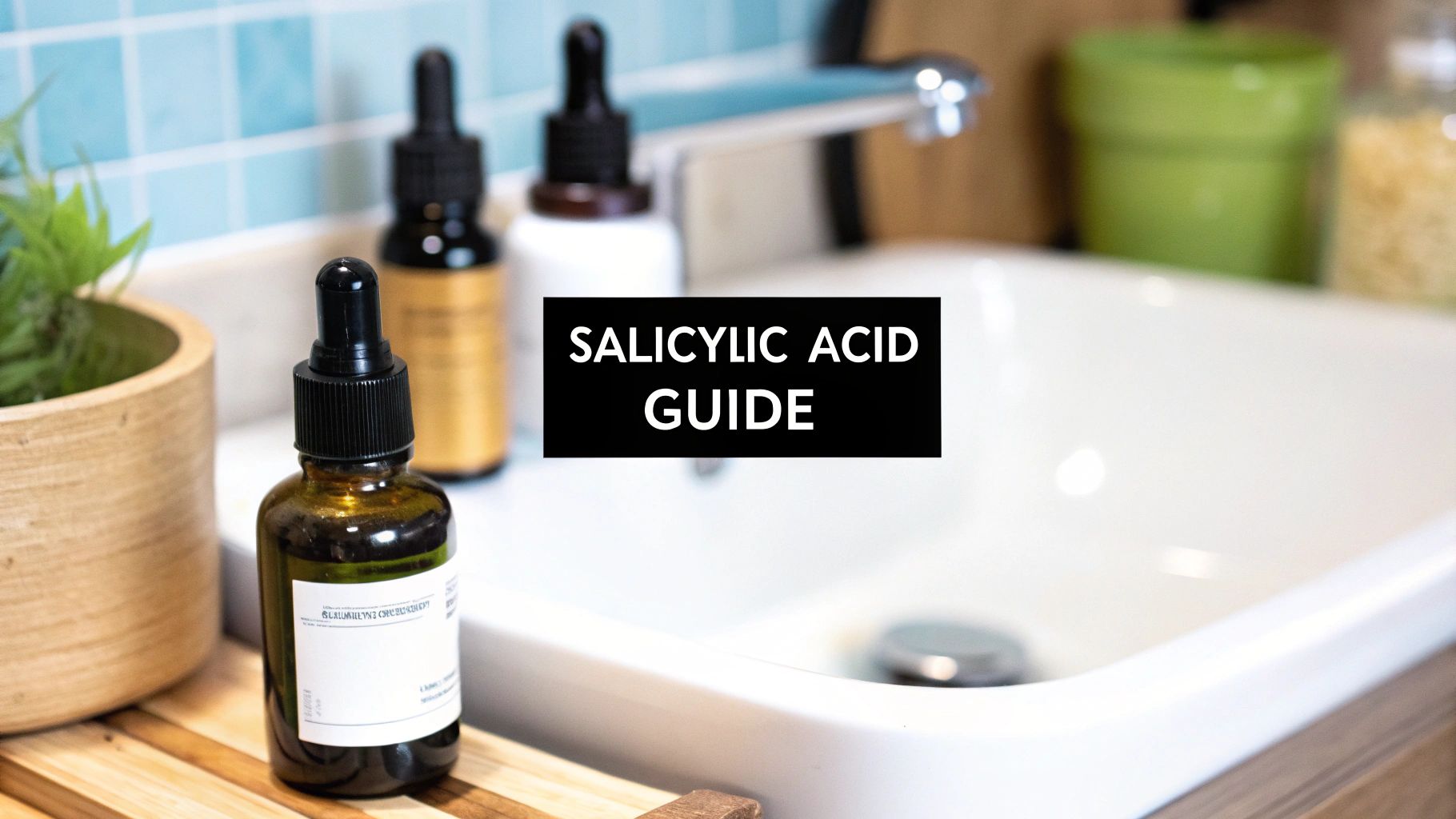
If you're staring at clogged pores, dealing with stubborn blackheads and whiteheads, or just tired of an oily T-zone, it's probably time to consider salicylic acid. Think of it as your secret weapon for clearing out congestion and stopping breakouts before they have a chance to surface.
But like any powerful tool, timing is everything. Using it correctly depends on what your skin can handle and the strength of the product you choose. At Neutralyze, we specialize in harnessing the power of key ingredients like salicylic acid to deliver clear, balanced skin, and we're here to guide you.
Your Quick Guide to Using Salicylic Acid
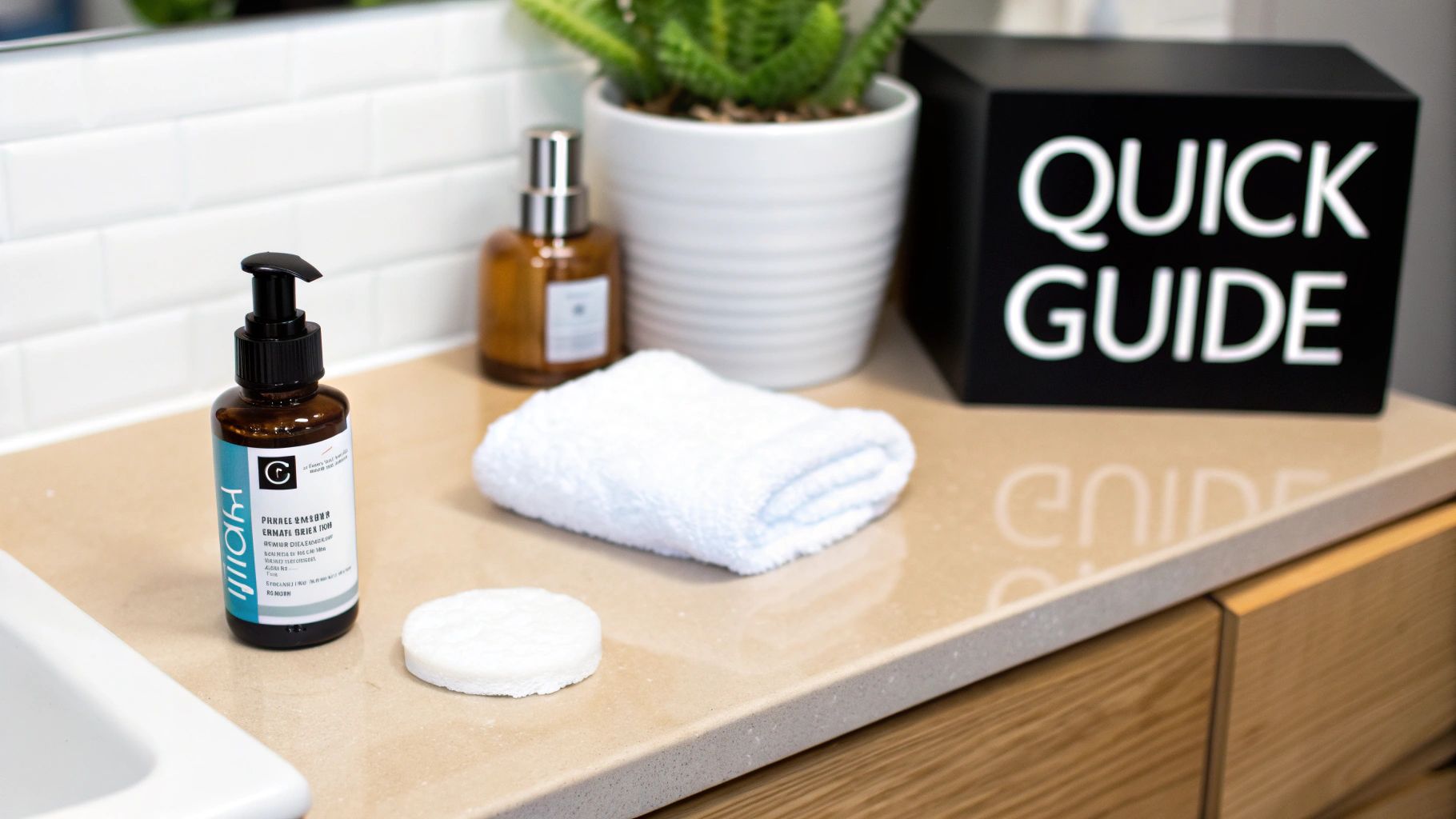
Let's cut through the noise. Salicylic acid is a standout ingredient for a reason, and it's simpler to use than you might think.
It’s a beta-hydroxy acid (BHA), which sounds technical, but all it really means is that it's oil-soluble. Unlike other acids that just work on the skin's surface, salicylic acid can dive deep into your pores and dissolve the gunk—oil, dead skin cells, and debris—that causes breakouts in the first place.
This unique skill makes it a game-changer for certain skin issues. Figuring out when to work it into your routine is the key to getting that clear, balanced complexion you're after.
The Best Times to Use Salicylic Acid
So, what's the perfect moment to deploy this ingredient? It all comes down to what your skin needs right now.
Dermatologists have long relied on salicylic acid to treat acne and other conditions involving scaly skin, thanks to its exfoliating and anti-inflammatory magic. Most over-the-counter products you'll find contain 0.5% to 2% salicylic acid, which is the sweet spot for effectiveness.
Here’s when you should reach for a salicylic acid product:
- You're seeing persistent blackheads and whiteheads. It’s a master at dissolving the very plugs that cause these annoying spots.
- Your skin feels oily or congested. It helps get oil production under control and keeps your pores from getting clogged.
- You have red, angry pimples. Its anti-inflammatory properties help calm down the redness and swelling associated with active breakouts.
Expert Tip: Finding the right formula is just as important as when you use it. You want a product that's effective without being harsh, delivering results without causing a new set of problems like redness or peeling. This is the expertise Neutralyze brings to every formula.
This guide will give you the quick, practical answers you need. If you're ready to see what this ingredient can do for you, feel free to explore our Salicylic Acid product collection.
For a quick reference, this table breaks down the essentials.
When to Use Salicylic Acid At a Glance
| Use Salicylic Acid If You Have... | Best Time to Apply | Recommended Frequency |
|---|---|---|
| Oily, Acne-Prone Skin | PM, to allow it to work overnight without sun exposure. | Start with 2-3 times per week and increase if tolerated. |
| Combination Skin or Clogged Pores | PM, focusing on congested areas like the T-zone. | Begin with 1-2 times per week to avoid drying out clearer areas. |
| Occasional Breakouts | As a spot treatment, either AM or PM. | Apply directly to the blemish as needed, up to once daily. |
| Keratosis Pilaris ("Chicken Skin") | PM, on affected areas of the body. | 3-4 times per week on the body, which is less sensitive than the face. |
This table should help you pinpoint the best approach for your skin, making it easier to add salicylic acid into your routine with confidence.
How Salicylic Acid Actually Clears Your Pores
Before we jump into when you should use salicylic acid, let's get into how it actually works. It's not just another face wash. Think of it as a highly specialized tool, engineered to clear out your pores from the inside.
A lot of common exfoliants, like alpha-hydroxy acids (AHAs), are water-soluble. They do a great job of polishing the surface of your skin, but they can't really get past the oil clogging up your pores. This is where salicylic acid changes the game.
Salicylic acid is a beta-hydroxy acid (BHA), which means it’s oil-soluble. That’s its superpower.
This oil-loving quality allows it to slip past the skin's surface and dive deep down into the pore lining. Once it's in there, it starts dissolving that stubborn mix of sebum and dead skin cells—the gunk that leads to blackheads, whiteheads, and pimples.
Salicylic acid is like a microscopic plumber for your pores. It doesn't just clean the surface; it travels right to the source of the clog to break down the buildup, helping you get clearer skin from the inside out.
A Dual-Action Approach to Acne
But salicylic acid doesn't stop there. It delivers a powerful one-two punch against breakouts, tackling both the cause of the problem and the frustrating symptoms you see in the mirror. It’s about more than just cleaning; it’s about bringing your skin back into balance.
This is exactly why it’s a go-to for anyone dealing with stubborn acne.
- Deep Pore Exfoliation: By dissolving the gunk inside your pores, salicylic acid helps prevent new blockages from forming in the first place. This proactive approach is key for keeping future breakouts at bay.
- Calming Inflammation: On top of that, salicylic acid has anti-inflammatory properties. It actively works to calm the redness, swelling, and general "angry" look of a pimple, helping it heal faster.
Why Formulation Is Everything
Knowing how it works makes one thing clear: just having salicylic acid listed on a label isn't enough. Its real power comes down to the formulation. You need a product that can get the ingredient deep into the pores without stripping your skin and causing a ton of irritation.
This is where a thoughtfully crafted formula, like those from Neutralyze, makes a world of difference. We focus on maximizing the pore-clearing and anti-inflammatory benefits while including soothing ingredients that keep your skin barrier happy. It’s about targeted delivery—getting all the power without the punishment.
For a deeper dive into the mechanics of pore clearing, a good guide on how to clean out pores for clearer skin can be incredibly helpful. Ultimately, the right product turns this potent BHA into a gentle, consistent ally in your journey to clear skin.
Finding the Right Timing for Your Skin Type
When it comes to using salicylic acid, there's no universal rulebook. The real secret is learning to read your own skin. A one-size-fits-all approach is a recipe for irritation or just plain disappointing results. To truly unlock its pore-clearing magic, you have to tailor its use to your specific skin type.
This personalized strategy is all about creating a routine that works for you, not against you. Whether your skin feels like an oil slick or is prone to sensitivity, there’s a smart way to bring this powerful BHA into your life.
For Oily and Acne-Prone Skin
If your skin is constantly fighting off excess oil and breakouts, salicylic acid can be your daily hero. The main goal here is maintenance—keeping those pores clear day in and day out to stop blemishes before they even start.
Try using a salicylic acid cleanser or toner once a day, usually at night. This helps dissolve all the grime, oil, and dead skin cells that have built up. Consistent use is the key; over time, you should see a real drop in how often you break out and how severe those breakouts are.
This little decision tree can help you visualize how to approach salicylic acid based on what your skin is telling you.
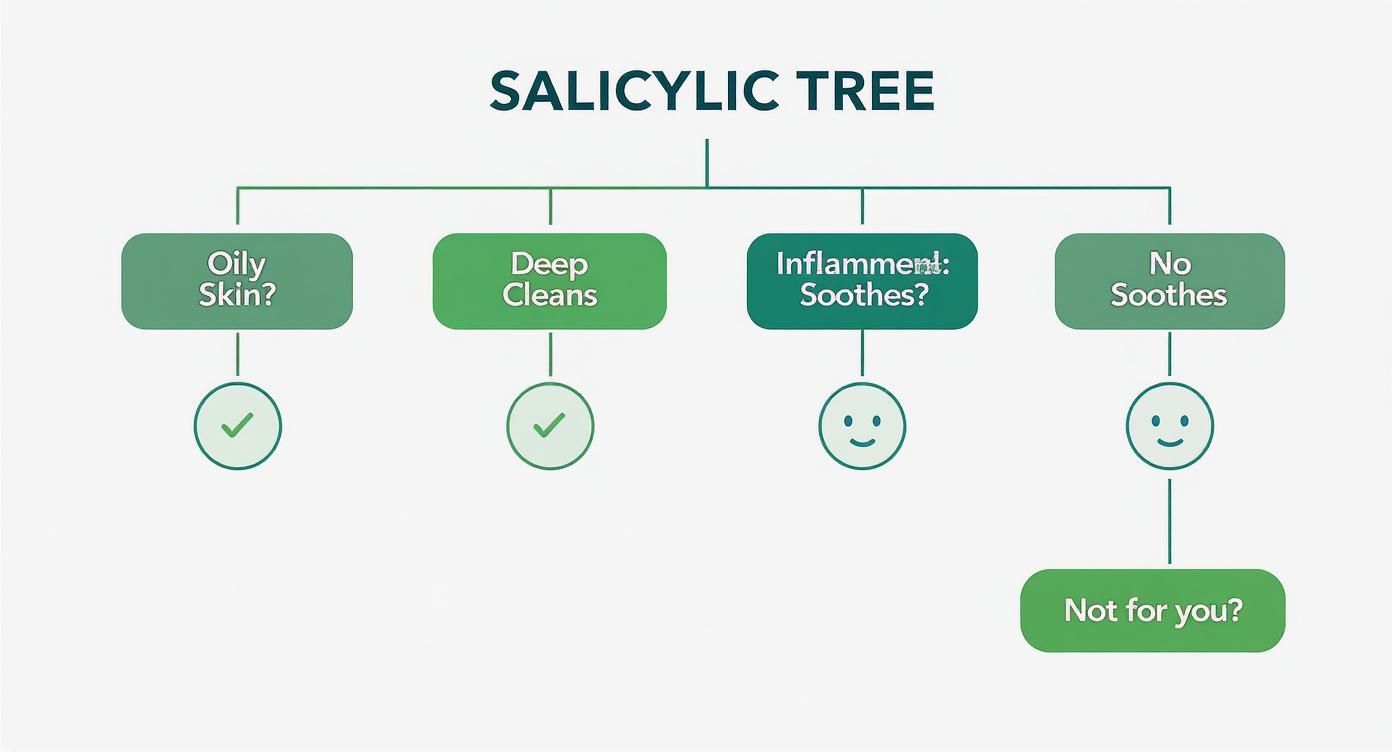
As you can see, it's not just about deep cleaning for oily types; even inflamed skin can find some much-needed relief.
For Combination Skin
With combination skin, you have to be more strategic. You're basically dealing with two different climates on your face: an oily T-zone (forehead, nose, chin) and much drier cheeks. Slathering salicylic acid everywhere might just leave your cheeks feeling tight and angry.
Instead, think of it as a targeted tool. Use it as a spot treatment or focus only on congested areas. A great trick is to apply a serum or toner with a cotton pad just to the T-zone a few times a week. This helps you tackle blackheads and oil where they live, without messing with the happy balance of your cheeks.
Listen to Your Skin: This is the golden rule. If you see redness, notice peeling, or feel that uncomfortable tightness, your skin is waving a red flag. It’s a clear signal to dial back how often you’re using the product. Healthy skin should feel comfortable and balanced, not stressed out.
For Sensitive Skin
Even if your skin is on the sensitive or dry side, you don't have to miss out. The key is to start low and go slow. Pushing sensitive skin too hard can damage its protective barrier, which only leads to more trouble.
Begin with a product that has a low concentration—look for something around 0.5% to 1%—and only use it once or twice a week to start. This lets your skin get used to it without freaking out. Many modern formulas, like those from Neutralyze, are specifically designed to be both effective and gentle by pairing salicylic acid with calming ingredients that work well for all sorts of skin needs.
Salicylic acid has become a superstar in cosmetics for a reason. It's incredibly good at exfoliating and clearing out pores. You'll find it in countless over-the-counter products at concentrations between 0.5% and 2%, which makes it a really accessible ingredient for most people. If you're curious, you can learn more about the rising popularity of this ingredient and why it's showing up everywhere.
How to Fit Salicylic Acid Into Your Daily Routine
Okay, so you’ve figured out your skin type and know salicylic acid is for you. Now for the next puzzle: where exactly does it fit into your daily lineup? Getting this right is the secret to unlocking its benefits without sending your skin into a state of irritation.
The timing often boils down to the specific product you’re using. A salicylic acid cleanser, for instance, can work perfectly well in the morning or at night. But when it comes to leave-on treatments like serums or toners, nighttime is usually your best bet.
Why? Applying it before bed gives the acid hours of uninterrupted time to work its magic. As you sleep, your skin enters its natural repair cycle, and the salicylic acid can get deep into your pores to dissolve all that gunk. This approach also sidesteps any potential issues with sun sensitivity, letting you wake up to a noticeably smoother, clearer complexion.
The Correct Order of Application
To get real results from any active ingredient, the order you apply it in matters. A lot. Think of it like painting a wall—you wouldn't put on the color before the primer, right? Applying your products out of order can render them less effective or, in some cases, completely useless.
For a leave-on salicylic acid product, the rule is refreshingly simple: it goes on after cleansing and before moisturizing. This gives the BHA a clean, clear canvas to work on, without having to fight its way through a thick layer of cream.
- Cleanse: Start with a gentle face wash to get rid of makeup, dirt, and oil.
- Apply Salicylic Acid: Gently pat your skin dry. Apply your salicylic acid toner, serum, or spot treatment and give it a minute to fully absorb.
- Moisturize: Lock everything in with a good, hydrating moisturizer. This is non-negotiable, as it supports your skin barrier and keeps dryness at bay.
What Not to Mix With Salicylic Acid
Just as important as when you use salicylic acid is knowing what not to use it with in the same routine. It's easy to get excited and throw everything at your skin, but layering too many powerful active ingredients is a recipe for disaster. This can lead to over-exfoliation, which looks and feels like redness, peeling, and a damaged skin barrier.
A healthy skin barrier is your face’s first line of defense. When you overload it with too many potent actives at once, you weaken it, which ironically can make you more prone to the breakouts you were trying to fix.
A good rule of thumb is to avoid using salicylic acid at the exact same time (i.e., in the same morning or night routine) as other strong exfoliants. This includes high-concentration AHAs like glycolic acid or certain retinoids. For example, using adapalene and salicylic acid together requires a careful strategy; for more detail, check out our guide on combining these ingredients safely. This is where a well-designed system like Neutralyze really shines, as our products are formulated to work in harmony, delivering powerful results without causing conflict.
The demand for powerhouse ingredients like this is skyrocketing. In fact, the market for pharmaceutical-grade salicylic acid is projected to hit nearly USD 586.2 million by 2025, fueled by a growing global focus on skincare health. You can discover more insights about this trend on archivemarketresearch.com. It just goes to show how critical it is to learn how to use such a popular ingredient the right way.
Common Mistakes to Avoid for Best Results
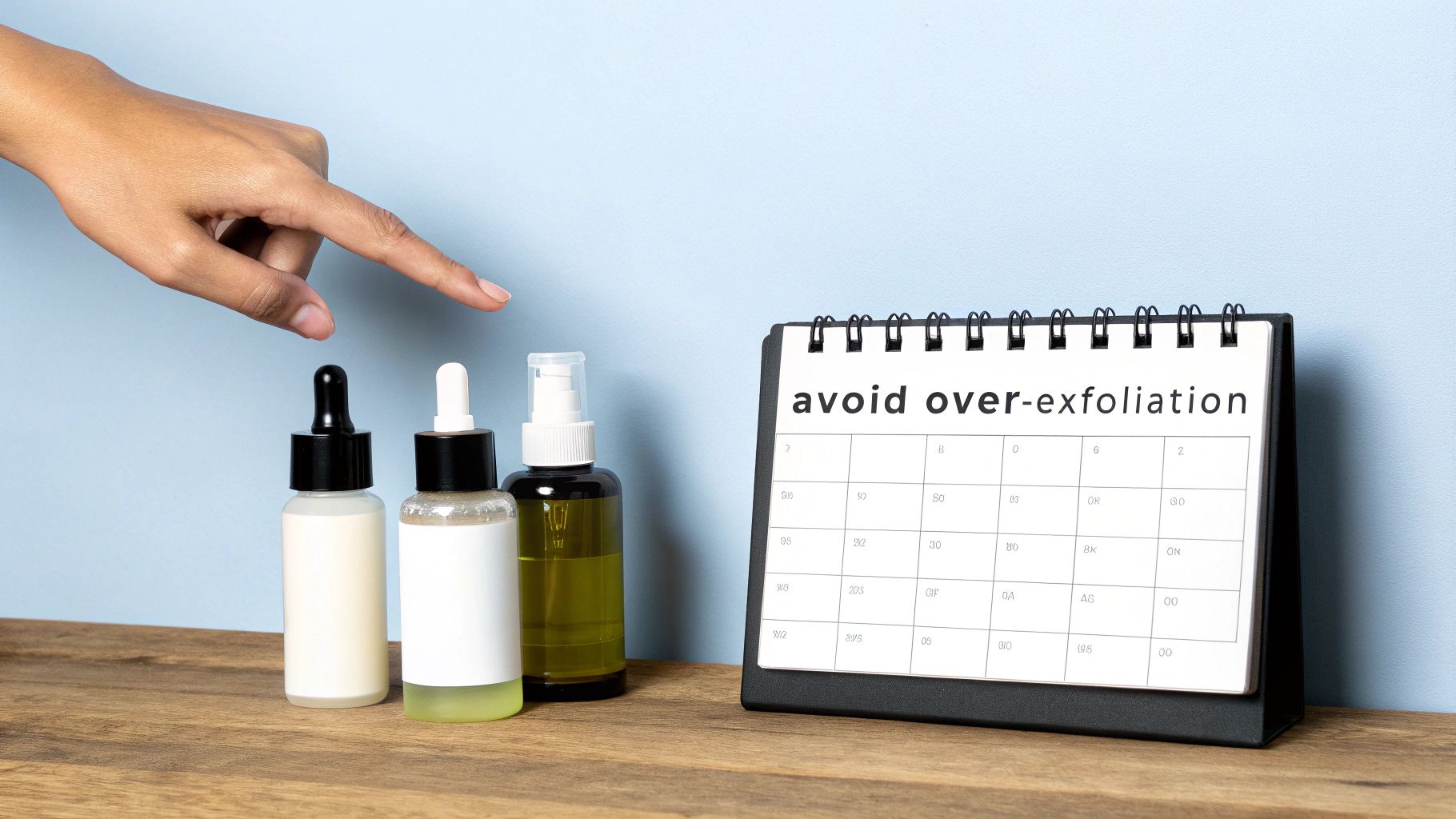
Knowing when to use salicylic acid is only half the battle. Figuring out how to use it correctly is what truly makes the difference for your skin. Even a powerhouse ingredient like this can backfire if you fall into a few common traps, so let’s talk about what not to do.
The biggest mistake I see people make is over-exfoliation. It's so tempting to think that if a little bit helps, then a lot must be a miracle worker, right? Unfortunately, that's not how it works. Using salicylic acid too often, or piling on other strong actives, can completely strip your skin’s natural protective barrier.
The irony is that this damage can lead to more inflammation, redness, and breakouts—the very things you were trying to fix in the first place.
The Dangers of Over-Exfoliation
Think of your skin barrier like a strong shield. When it's healthy, it masterfully keeps moisture locked in and irritants locked out. But over-exfoliation pokes holes in that shield, leaving your skin vulnerable, sensitive, and reactive.
You'll know your barrier is in trouble if you start seeing these signs:
- Redness that just won't go away.
- That tight, squeaky, uncomfortable feeling after washing your face.
- Products that used to be fine suddenly start to sting.
- Your skin looks flaky, rough, or starts peeling.
If any of this sounds familiar, it's a huge red flag telling you to pull back on the exfoliants. This idea of being both gentle and effective is at the core of how Neutralyze creates its products. The goal is always maximum results without punishing your skin.
Forgetting Sunscreen Is a Major Mistake
Here's another non-negotiable rule: if salicylic acid is in your routine, sunscreen must be too. Every single day. By clearing away old, dead cells, exfoliants bring fresh, new skin to the surface. That new skin is beautiful, but it's also far more vulnerable to sun damage.
Skipping sunscreen is basically rolling out the welcome mat for sunspots, hyperpigmentation, and premature aging.
Make applying a broad-spectrum sunscreen with at least SPF 30 a non-negotiable part of your morning. It is the single best thing you can do to protect the progress you're making and keep your skin healthy for the long haul.
Patience is a Skincare Virtue: Real results don't happen overnight. It can take 4-6 weeks of consistent use before you see a significant change in your skin's texture and how often you break out. Stick with it and trust the process.
Finally, keep in mind that skincare science is always moving forward. New research on ingredient combinations and delivery systems is making actives like salicylic acid safer and more effective than ever. You can actually explore more about these developments on archivemarketresearch.com. This commitment to science-backed progress is what allows brands like Neutralyze to offer some of the best solutions for both treating and maintaining clear skin.
Why Trust Neutralyze on Your Skincare Journey?
Getting clear, healthy skin that stays clear isn't about finding one magic ingredient. It's about finding a smart, science-first system that works for you, day in and day out. You need products you can count on to do their job without making things worse. That’s exactly where we come in.
Knowing when to use salicylic acid is a great first step, but the real magic happens in the formula itself. We don't just throw salicylic acid into a bottle and call it a day. We build sophisticated treatments that combine its powerful pore-clearing abilities with ingredients that actively calm and soothe your skin.
This thoughtful approach means you get all the benefits—unclogged pores, fewer breakouts, smoother texture—without the classic downsides like redness and peeling that often come with less-balanced products.
A Complete System Built for Clear Skin
Trying to figure out acne treatment on your own can be overwhelming. Neutralyze is designed to be your clear, simple roadmap. Our products are created to work in harmony, building a complete routine that tackles breakouts from every angle. It’s about treating the acne you have now, preventing the next round, and keeping your skin in a happy, healthy state.
Our mission is simple but powerful: to provide gentle, science-backed solutions that give you visible, lasting results. We’re firm believers that you don’t have to destroy your skin’s barrier to defeat acne.
Gentle Strength for Results That Last
For a long time, the thinking around acne treatment was that it had to be harsh to work. We know better. The entire Neutralyze system is founded on the principle of gentle efficacy. We use the best of skincare science to formulate products that are tough on breakouts but incredibly kind to your skin.
When you choose Neutralyze, you're not just buying a product; you’re investing in a philosophy:
- Smarter Formulas: We pair potent active ingredients with calming, supportive ones to keep your skin in balance.
- A Proven Path: Our complete kits take the guesswork out of building a routine, guiding you straight toward your goals.
- Real Transformation: Join the more than 475,000 happy customers who have trusted Neutralyze to help them find the clear, confident skin they’ve always wanted.
Your Salicylic Acid Questions, Answered
Even after getting the basics down, you probably still have a few specific questions about fitting salicylic acid into your routine. Getting those sorted out is the key to using this ingredient confidently and correctly. Let's dig into some of the most common ones we get.
Can I Use Salicylic Acid Every Day?
This really comes down to your unique skin and the strength of the product you’re using.
If you have oily, resilient skin, you might be able to use a 2% salicylic acid product every day without a problem. But if your skin leans dry or sensitive, a much safer bet is to start with just 2-3 times per week.
The most important thing is to listen to your skin. If you see any redness, feel any stinging, or notice excessive peeling, that’s your cue to pull back.
Should I Use It in the Morning or at Night?
For leave-on treatments like serums or toners, nighttime is generally the best choice. This gives the salicylic acid hours to work its magic, uninterrupted, while your skin is in its natural repair and regeneration mode.
That said, using a salicylic acid cleanser in the morning can be a great way to start the day fresh and keep pores clear.
The Golden Rule: If you use any salicylic acid product in the morning, following it up with a broad-spectrum sunscreen of SPF 30 or higher is non-negotiable. Freshly exfoliated skin is more susceptible to sun damage, so protection is a must.
Interestingly, market data shows that demand for salicylic acid often spikes in the colder months. This is likely because people deal with more breakouts and flaky skin during this time, making a good exfoliant a top priority. You can actually read more about these skincare market trends on chemanalyst.com.
How Long Does It Take to See Results?
You might see a single, angry pimple look a little less red and inflamed within a day or two, but the real changes take time.
For a noticeable improvement in your skin's overall texture, clarity, and a reduction in breakouts, you'll need to be consistent for about 4-6 weeks. Skincare is a marathon, not a sprint. Patience and sticking with your routine are what will get you to the finish line.
Ready to start your journey to clear, healthy skin with a system you can trust? Neutralyze offers science-backed formulas that deliver powerful results gently. Discover the complete Neutralyze acne-fighting system today!
